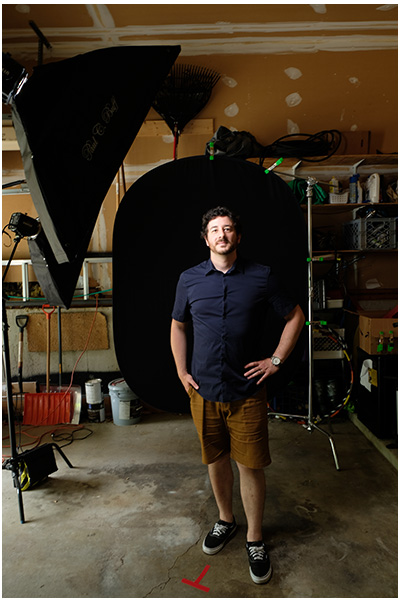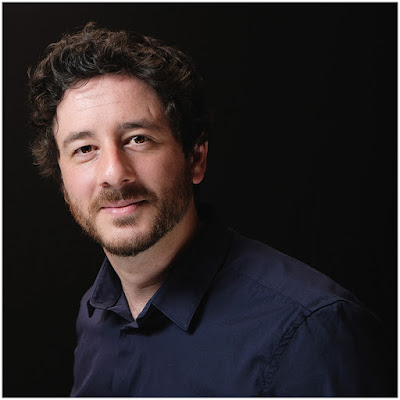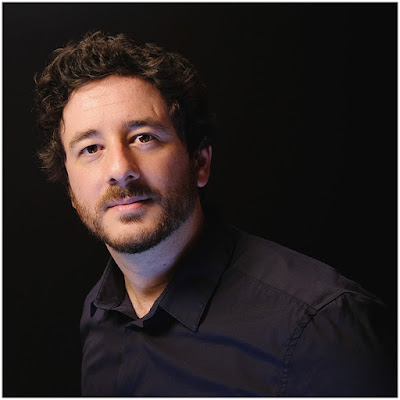Lighting 103: Greg's Assignment: Results
Abstract: So, did you do Greg's gels assignment? I did. Twice. Below are my results, and what I learned.

Reporting in from our last assignment, in which you were asked to shoot a portrait in three different ways: clean white light, warm/cool light, and warm/cool light with the shadows muddied up with a little green. I did this one along with you—twice—and learned a lot in the process.
Which brings up a valuable point. You can read about this stuff all you want. But until you actually get off your ass and do it, you're not going to learn it.
In other words, learning to use color in your lighting is just like anything else.
Greetings from the Garage Mahal

I shoot the vast majority of my work on location, with a small gear bag and without an assistant. But to experiment like this you need both space and control. So I tapped the resources of the fabulous Garage Mahal studios, which is basically the biggest empty box I can wrangle at my house. I can sense your jealousy from here.
Why the garage? Because I suspected that having nearby walls (as in my living room) might be a bad thing for throwing back light—especially as the bounceback of warm and cool mixes and robs itself of the complimentary colors. This suspicion was confirmed with some of the pictures you guys showed me from your own efforts, via Twitter.
Along those same lines, I wanted to minimize the spilled/reflected light at the source. So I did not shoot with umbrellas. Because they basically go off like a hand grenade, spilling lots of raw and reflected light in other directions. If an umbrella is all you have, this can be mitigated by draping some black nylon over the back of the umbrella (behind your flash) to kill the spill and reflected light. A reflective, black-backed umbrella also might be better for this sort of thing than a shoot-through.
For my first run-through I had the help of local photographer/gel mannequin Andy DelGiudice, who was a trouper as we tried out various combos of key and fill gels to see what worked best.
Clean, Gelled, Dirtied

We started off with clean light: Big soft box at camera left, little strip box at low camera right. And just to keep his hair separating from the dark background, a speedlight off of the ceiling behind him. The ceiling is unpainted drywall, and brown, so the separation light picked up some warmth.

Next we used a 1/2 CTO on the key and a 1/2 CTB on the fill. This looks better, but Heisler is right. There is definitely some magenta happening in the shadows with the 1/2 CTB as fill. There is also some crosstalk of sorts—the fill and key are contaminating each other in areas where they both hit. Mostly warm key wiping out blue fill and getting weaker as a result.

Adding a 1/2 PlusGreen to the 1/2 CTB fill cleans up the magenta cast. But the contamination is still happening between key and fill.

As we are swapping colors out, I am realizing that using the small gel discs for the big soft boxes is a game changer. I can't believe I used to gel full front panels.

Also, I have leared that a large soft box, lined with Velcro® is the natural enemy of a water-wicking athletic T-shirt. Especially if you are crawling inside the box to change gels. I look like I lost a fight with a cat.
Let's Change it Up
Now that we are getting our sea legs, lets start paying more attention to the location of the lights. In particular, it really seems to matter where the fill light is. You don't want it to be contaminated by the key light. You want it placed to just take over as the key light falls into shadow.
This is something I did not know before brute force experimenting today, and it is different than how I have worked in the past.

Better, right? This is a full CTB (I am getting a little less weenie about color) with a 1/2 PlusGreen in the shadows. Key light is still a 1/2 CTO.
But lit discretely (i.e., little to no crossover) they look way better together. Learning.

Here is a clean version (no gels) for comparison. Which, like the previous shot, is pretty much straight out of the camera. It looks fine, until you see the gelled version. Then it looks like dog poop.
Round Two
I set up two sessions of experimenting with this stuff, to try to build a little muscle memory and get enough confidence to try it on a live shoot later.
So I had DC-based political consultant (and sometimes photographer) David Solimini up to do some photos.
With what I had learned from shooting Andy, there was much less fumbling with gel strengths for David. And I had a better handle on the fill light position, too.
Here he is, 1/2 CTO key, full CTB + 1/2 PlusGreen fill:

Hey, this is starting to look good. And I was able to knock it out pretty quickly, too. Which is an important point: the more times you play with this, the better you will get at finding your sweet spot quickly. (He said after two whole tries.)
Seriously, though. Check out a bigger version and look at David's face and hands. This is starting to look like what I want.
But I am still learning stuff. Even after the fact, during editing. For instance, I'm now seeing that you can easily modulate the strength of the light on the hands vs. the face by how high you place the fill light. I'd like a little less on his hands and more on his face here, for instance. (But not complaining! I'm happy with this for my second try ever.)
Building Skills
As it happens, I had a band shoot the day after my second gel test. And having seen it work even better the second time out of the box, I did not think twice about trying it on a location assignment.
Five-person group, classical woodwinds. I warm the key and immediately full-CTB'd and 1/2 PlusGreened the fill. Looked great. In fact, didn't look like fill—it just looked like light from a nondescript-but-interesting interesting environment.
Which is exactly the goal.
Here's a fun tidbit. When he lived in New York City, Greg Heisler kept a studio in Manhattan. He almost never shot jobs there. In fact, he tells me he can't remember if he ever shot a job there.
But he wanted a nearby studio to have for testing, over and over. So he paid rent—Manhattan rent—to have a studio in which to test, so he would be better prepped for his location shoots.
Given that, I don't feel so bad about spending a couple days in my garage testing gels. And it's already paying benefits.
What about you guys? What are you thinking? Hit me on Twitter. And show me your own results if you do this, too...
NEXT: Avoiding Cross Contamination

Reporting in from our last assignment, in which you were asked to shoot a portrait in three different ways: clean white light, warm/cool light, and warm/cool light with the shadows muddied up with a little green. I did this one along with you—twice—and learned a lot in the process.
Which brings up a valuable point. You can read about this stuff all you want. But until you actually get off your ass and do it, you're not going to learn it.
In other words, learning to use color in your lighting is just like anything else.
Greetings from the Garage Mahal

I shoot the vast majority of my work on location, with a small gear bag and without an assistant. But to experiment like this you need both space and control. So I tapped the resources of the fabulous Garage Mahal studios, which is basically the biggest empty box I can wrangle at my house. I can sense your jealousy from here.
Why the garage? Because I suspected that having nearby walls (as in my living room) might be a bad thing for throwing back light—especially as the bounceback of warm and cool mixes and robs itself of the complimentary colors. This suspicion was confirmed with some of the pictures you guys showed me from your own efforts, via Twitter.
Along those same lines, I wanted to minimize the spilled/reflected light at the source. So I did not shoot with umbrellas. Because they basically go off like a hand grenade, spilling lots of raw and reflected light in other directions. If an umbrella is all you have, this can be mitigated by draping some black nylon over the back of the umbrella (behind your flash) to kill the spill and reflected light. A reflective, black-backed umbrella also might be better for this sort of thing than a shoot-through.
For my first run-through I had the help of local photographer/gel mannequin Andy DelGiudice, who was a trouper as we tried out various combos of key and fill gels to see what worked best.
Clean, Gelled, Dirtied

We started off with clean light: Big soft box at camera left, little strip box at low camera right. And just to keep his hair separating from the dark background, a speedlight off of the ceiling behind him. The ceiling is unpainted drywall, and brown, so the separation light picked up some warmth.

Next we used a 1/2 CTO on the key and a 1/2 CTB on the fill. This looks better, but Heisler is right. There is definitely some magenta happening in the shadows with the 1/2 CTB as fill. There is also some crosstalk of sorts—the fill and key are contaminating each other in areas where they both hit. Mostly warm key wiping out blue fill and getting weaker as a result.

Adding a 1/2 PlusGreen to the 1/2 CTB fill cleans up the magenta cast. But the contamination is still happening between key and fill.

As we are swapping colors out, I am realizing that using the small gel discs for the big soft boxes is a game changer. I can't believe I used to gel full front panels.

Also, I have leared that a large soft box, lined with Velcro® is the natural enemy of a water-wicking athletic T-shirt. Especially if you are crawling inside the box to change gels. I look like I lost a fight with a cat.
Let's Change it Up
Now that we are getting our sea legs, lets start paying more attention to the location of the lights. In particular, it really seems to matter where the fill light is. You don't want it to be contaminated by the key light. You want it placed to just take over as the key light falls into shadow.
This is something I did not know before brute force experimenting today, and it is different than how I have worked in the past.

Better, right? This is a full CTB (I am getting a little less weenie about color) with a 1/2 PlusGreen in the shadows. Key light is still a 1/2 CTO.
But lit discretely (i.e., little to no crossover) they look way better together. Learning.

Here is a clean version (no gels) for comparison. Which, like the previous shot, is pretty much straight out of the camera. It looks fine, until you see the gelled version. Then it looks like dog poop.
Round Two
I set up two sessions of experimenting with this stuff, to try to build a little muscle memory and get enough confidence to try it on a live shoot later.
So I had DC-based political consultant (and sometimes photographer) David Solimini up to do some photos.
With what I had learned from shooting Andy, there was much less fumbling with gel strengths for David. And I had a better handle on the fill light position, too.
Here he is, 1/2 CTO key, full CTB + 1/2 PlusGreen fill:

Hey, this is starting to look good. And I was able to knock it out pretty quickly, too. Which is an important point: the more times you play with this, the better you will get at finding your sweet spot quickly. (He said after two whole tries.)
Seriously, though. Check out a bigger version and look at David's face and hands. This is starting to look like what I want.
But I am still learning stuff. Even after the fact, during editing. For instance, I'm now seeing that you can easily modulate the strength of the light on the hands vs. the face by how high you place the fill light. I'd like a little less on his hands and more on his face here, for instance. (But not complaining! I'm happy with this for my second try ever.)
Building Skills
As it happens, I had a band shoot the day after my second gel test. And having seen it work even better the second time out of the box, I did not think twice about trying it on a location assignment.
Five-person group, classical woodwinds. I warm the key and immediately full-CTB'd and 1/2 PlusGreened the fill. Looked great. In fact, didn't look like fill—it just looked like light from a nondescript-but-interesting interesting environment.
Which is exactly the goal.
Here's a fun tidbit. When he lived in New York City, Greg Heisler kept a studio in Manhattan. He almost never shot jobs there. In fact, he tells me he can't remember if he ever shot a job there.
But he wanted a nearby studio to have for testing, over and over. So he paid rent—Manhattan rent—to have a studio in which to test, so he would be better prepped for his location shoots.
Given that, I don't feel so bad about spending a couple days in my garage testing gels. And it's already paying benefits.
What about you guys? What are you thinking? Hit me on Twitter. And show me your own results if you do this, too...
NEXT: Avoiding Cross Contamination
__________
New to Strobist? Start here | Or jump right to Lighting 101
My new book: The Traveling Photograher's Manifesto
Permalink
<< Home